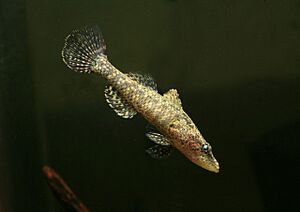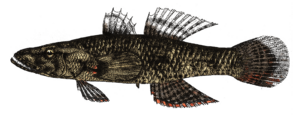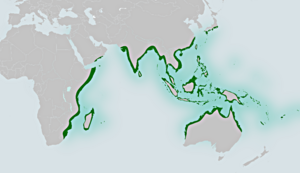Crazy fish facts for kids
Quick facts for kids Crazy fish |
|
|---|---|
 |
|
 |
|
| Conservation status | |
| Scientific classification | |
| Synonyms | |
|
The crazy fish (scientific name: Butis butis) is a unique type of fish known for its strange swimming style. It's also called the duckbill sleeper or upside-down sleeper. These fish live in coastal areas, especially where fresh water mixes with salty ocean water (called brackish water). You can find them in the Indian Ocean and the western Pacific Ocean, from Africa all the way to the islands of Fiji.
Crazy fish love places with lots of plants, like mangrove swamps. They are small, usually growing to about 15 centimeters (6 inches) long. They are hunters and are famous for swimming vertically, or even upside down, when they are looking for food!
Contents
What Does a Crazy Fish Look Like?
Crazy fish are usually between 7 and 15 centimeters (3 to 6 inches) long. Their head is a bit flat and wide, especially from their snout to just behind their eyes. They have a very large mouth, and their lower jaw sticks out further than the upper one. Inside their mouth are many rows of tiny, sharp teeth, like bristles.
They have two pairs of nostrils on each side of their snout. Their eyes are quite small and are located near the top of their head, but they look sideways. Their eyes are gold and black. The rest of their body is flattened from side to side.
Fins and Scales
Crazy fish have two dorsal fins (on their back). The first one is arched, and the second one is roughly the same size and shape as their anal fin (on their belly). They have short, triangular ventral fins located far forward on their body. Their pectoral fins (on their sides, like arms) are large and rounded. Their tail fin, called the caudal fin, is wide and rounded.
Most of their body is covered in scales, except for their mouth, chin, and the tip of their snout. The scales on their head and sides are rough (called ctenoid scales), while the scales on their belly are smooth (called cycloid scales).
Colors and Patterns
Crazy fish usually have dull colors, like dusky gray or olive green. They have five or six dark bands across their body, which are clearer towards their tail. Sometimes, a black stripe runs from their snout, across their eye, and towards their gill cover. Dark spots also spread out from around their eyes.
Each scale on their body has a pale spot, which creates noticeable lines along their body. They might also have one or two red or pinkish spots near their pectoral fins. Their fins can be clear or have rows of black and light bars. Some crazy fish even have bright red edges on their fins! However, their pectoral fins are always clear.
Crazy Fish Names and History
Crazy fish are part of a group called Butis within the family Butidae. This family used to be considered a smaller group within the Eleotridae family, which are known as sleeper gobies.
The crazy fish was first described in 1822 by a Scottish scientist named Francis Buchanan-Hamilton. He found a specimen in the Ganges River in India. He first gave it the name Cheilodipterus. Later, other scientists moved it to different groups, until a Dutch scientist named Pieter Bleeker put it in its own group, Butis, in 1856.
The name "butis" likely comes from an Indian word for decorative circular designs on sari fabric. This probably refers to the crazy fish's spotted patterns.
Other Names for the Crazy Fish
This fish has many common names around the world! Here are a few:
- In English: upside-down sleeper, crimson-tipped gudgeon, duckbill sleeper, crocodile fish, flat-headed gudgeon, pointed-head gudgeon, and bony-snouted gudgeon.
- In Afrikaans: eendbek-slaper
- In Bengali: kuli (কুলি)
- In Finnish: kuonotorkkuja
- In French: butis à épaulette noire
- In German: Spitzkopfgrundel
- In Indonesian and Malaysian: nyereh, ploso, puntang, belosoh, belontok, ubi, and ubi muncung itik
- In Javanese: bloso-watu
- In Mandarin: jǐ táng lǐ (嵴塘鳢)
- In Sinhalese: vaneya
- In Thai: bukletkhaeng (บู่เกล็ดแข็ง)
- In Vietnamese: cá bống cấu, cá bống đầu dẹp, and cá bong trân
Where Do Crazy Fish Live?
Crazy fish live in brackish (slightly salty) and freshwater areas close to the coast. Sometimes, they can even be found further up rivers. They are demersal fish, which means they usually stay near the muddy bottoms of lagoons, estuaries (where rivers meet the sea), and mangrove forests. They prefer places with lots of plants.
These fish are found across a very wide area. You can see them from East Africa all the way to Fiji in the east. They also live north of the South China Sea and south to Australia and New Caledonia. This includes many islands in the Indian Ocean and Pacific Oceans.
Some of the countries where crazy fish are found include Australia, Brunei, Cambodia, China, Fiji, India, Indonesia, Japan, Kenya, Madagascar, Malaysia, Mauritius, Mozambique, Myanmar, Papua New Guinea, the Philippines, Seychelles, Singapore, Somalia, Sri Lanka, Taiwan, Tanzania, Thailand, and Vietnam.
How Do Crazy Fish Behave?
Crazy fish are hunters. They eat crustaceans (like crabs and shrimp), small fish, and worms. They are territorial, meaning they defend their space. They are most active during twilight (dawn and dusk) and at night.
Their most famous behavior is how they position themselves. They often align their bodies against the nearest surface, which makes them look horizontal, vertical, or even upside down! They use this trick to hide and then ambush their prey. They can also slightly change colors to blend in with their surroundings. During the monsoon seasons, the reddish edges of their fins might turn paler (orange or white), and many reddish spots can appear on the lower half of their body. The upper part of their tail fin might also turn white.
Why Are Crazy Fish Important?
Crazy fish are sometimes caught and sold to people who keep them in aquariums as pets. They are also edible, so sometimes people fish for them to eat. Because they are quite common, the IUCN lists them as a species of "Least Concern". This means they are not currently in danger of disappearing.
See also



